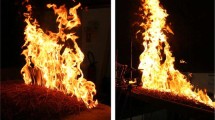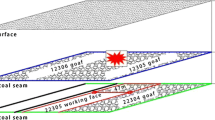Abstract
A new Outdoor Gas Emission Sampling (OGES) system was developed to serve as a low-cost alternative to expensive industrial gas sampling equipment. This research showed its effectiveness in sampling a smoke plume from multiple points simultaneously, obtaining gas concentration curves for common products of combustion such as CO2 and CO in meso-scale experiments. The optimal height for combustion product sampling was determined based on a variety of factors, most notably CO/CO2 ratio, which showed to be most consistent when located in the intermittent and plume regime of the McCaffrey plume. Large-scale field tests at U.S. Army Cold Regions Research and Engineering Laboratory (CRREL) in collaboration with the Environmental Protection Agency (EPA) demonstrated the potential of using OGES to evaluate the completeness of combustion for various fuels in a variety of settings. Oxygen Consumption (OC) and Carbon Dioxide Generation (CDG) methods in combination with plume theory results show the potential of using point sampling within a smoke plume to estimate HRR for fires that exceed the capabilities of conventional hood-based calorimeters.

















Similar content being viewed by others
Change history
22 May 2022
A Correction to this paper has been published: https://doi.org/10.1007/s10694-022-01264-9
References
Babrauskas V, Peacock RD (1992) Heat release rate: the single most important variable in fire hazard. Fire Saf J 18(3):255–272. https://doi.org/10.1016/0379-7112(92)90019-9
Tsuchiya Y (1982) Methods of determining heat release rate: state-of-the-art. Fire Saf J 5(1):49–57. https://doi.org/10.1016/0379-7112(82)90006-6
Drysdale DD (2016) Thermochemistry. In: Hurley MJ, Gottuk DT, Hall JR et al (eds) SFPE handbook of fire protection engineering. Springer, New York, pp 138–150
ASTM E1354-16a (2016) Standard test method for heat and visible smoke release rates for materials and products using an oxygen consumption calorimeter. ASTM International, West Conshohocken, PA
Janssens M, Parker WJ (1992) Oxygen consumption calorimetry. In: Babrauskas V, Grayson SJ (eds) Heat release in fires. Elsevier Applied Science, London, pp 31–60
Huggett C (1980) Estimation of rate of heat release by means of oxygen consumption measurements. Fire Mater 4(2):61–65. https://doi.org/10.1002/fam.810040202
Bryant R, Bundy M (2019) The NIST 20 MW calorimetry measurement system for large-fire research, Technical Note (NIST TN). National Institute of Standards and Technology, Gaithersburg
Khan MM, Tewarson A, Chaos M (2016) Combustion characteristics of materials and generation of fire products. In: Hurley MJ, Gottuk DT, Hall JR et al (eds) SFPE handbook of fire protection engineering. Springer, New York, pp 1143–1232
Cooper LY (1994) Some factors affecting the design of a calorimeter hood and exhaust. J Fire Prot Eng 6(3):99–111. https://doi.org/10.1177/104239159400600301
Evans DD, Mulholland GW, Baum HR, Walton WD, McGrattan KB (2001) In situ burning of oil spills. J Res Nat Inst Stand Technol 106(1):231–278. https://doi.org/10.6028/jres.106.009
Heskestad G (1984) Engineering relations for fire plumes. Fire Saf J 7(1):25–32. https://doi.org/10.1016/0379-7112(84)90005-5
Tukaew P (2017) Outdoor Gas Emission Sampling system: a novel method for quantification of fires in outdoor conditions. MS Thesis, Worcester Polytechnic Institute
Tukaew P, Arsava KS, Fields SL, Rangwala AS (2019) Outdoor Gas Emission Sampling system –performance during large scale fire tests in Mobile Alabama. In: Proceedings of the thirty-ninth AMOP =technical seminar on environmental contamination and response, Environment Canada, Halifax, Nova Scotia
Lizhong Y, Wenxing F, Junqi Y (2008) Experimental research on the spatial distribution of toxic gases in the transport of fire smoke. J Fire Sci 26(1):45–62. https://doi.org/10.1177/0734904107083632
McCaffrey BJ (1979) Purely buoyant diffusion flames: some experimental results. National Bureau of Standards, Washington, DC
Sibulkin M, Malary SF (1984) Investigation of completeness of combustion in a wall fire. Combust Sci Technol 40(1–4):93–106. https://doi.org/10.1080/00102208408923800
Aurell J, Gullett BK (2010) Aerostat sampling of PCDD/PCDF emissions from the Gulf oil spill in situ burns. Environ Sci Technol 44(24):9431–9437. https://doi.org/10.1021/es103554y
Aurell J, Gullett BK, Pressley C, Tabor DG, Gribble RD (2011) Aerostat-lofted instrument and sampling method for determination of emissions from open area sources. Chemosphere 85(5):806–811. https://doi.org/10.1016/j.chemosphere.2011.06.075
Aurell J, Gullett BK, Yamamoto D (2012) Emissions from open burning of simulated military waste from forward operating bases. Environ Sci Technol 46(20):11004–11012. https://doi.org/10.1021/es303131k
Hariharan SB, Farahani HF, Rangwala AS, Dowling JL, Oran ES, Gollner MJ (2021) Comparison of particulate-matter emissions from liquid-fueled pool fires and fire whirls. Combust Flame 227:483–496. https://doi.org/10.1016/j.combustflame.2020.12.033
McCaffrey BJ (1983) Momentum implications for buoyant diffusion flames. Combust Flame 52:149–167. https://doi.org/10.1016/0010-2180(83)90129-3
Morton BR, Taylor GI, Turner JS (1956) Turbulent gravitational convection from maintained and instantaneous sources. Proc R Soc Lond Ser A 234(1196):1–23. https://doi.org/10.1098/rspa.1956.0011
Aurell J, Gullett BK (2021) Analysis of emissions and residue from methods to improve combustion efficiency of in situ oil burns, heat transfer technology: Flame Refluxer. Final Report
Rangwala AS, Raghavan V (2022) Mechanisms of fire: chemistry and physical aspects. Springer, New York
Brohez S (2005) Uncertainty analysis of heat release rate measurement from oxygen consumption calorimetry. Fire Mater 29(6):383–394. https://doi.org/10.1002/fam.895
Shi X, Bellino PW, Rangwala AS (2015) Flame heat feedback from crude oil fires in ice cavities. In: Proceedings of the thirty-ninth AMOP technical seminar on environmental contamination and response, Environment Canada, Ottawa, ON, pp 767–776
Rangwala A, Arsava K, Sauer NG, Ho H, Nair S, Mahnken G, Kottalgi M (2021) Advancing the maturity of the flame refluxer technology. U.S. Department of the Interior, Bureau of Safety and Environmental Enforcement. Report No.: 1104. Contract No.: 140E0118R0007
Babrauskas V (2016) Heat Release Rates. In: Hurley MJ, Gottuk DT, Hall JR et al (eds) SFPE handbook of fire protection engineering. Springer, New York, pp 799–904
Babrauskas V (1983) Estimating large pool fire burning rates. Fire Technol 19(4):251–261. https://doi.org/10.1007/BF02380810
Acknowledgements
This study is funded by the Bureau of Safety and Environmental Enforcement, US Department of the Interior, Washington, D.C., under Contract Number 140E0119C0001. The contents do not necessarily reflect the views and policies of the BSEE, nor does mention of the trade names or commercial products constitute endorsement or recommendation for use.
Author information
Authors and Affiliations
Corresponding author
Additional information
Publisher's Note
Springer Nature remains neutral with regard to jurisdictional claims in published maps and institutional affiliations.
Rights and permissions
Springer Nature or its licensor (e.g. a society or other partner) holds exclusive rights to this article under a publishing agreement with the author(s) or other rightsholder(s); author self-archiving of the accepted manuscript version of this article is solely governed by the terms of such publishing agreement and applicable law.
About this article
Cite this article
Ho, HH., Arsava, K.S. & Rangwala, A.S. Burning Behavior Analysis in Meso and Large-Scale Oil Slick Fires With and Without Waves Using Outdoor Gas Emission Sampling (OGES) System. Fire Technol 58, 1963–1993 (2022). https://doi.org/10.1007/s10694-022-01234-1
Received:
Accepted:
Published:
Issue Date:
DOI: https://doi.org/10.1007/s10694-022-01234-1




